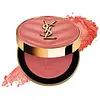Yves Saint Laurent Make Me Blush 24H Buildable Powder Blush Versus Gucci Luminous Matte Beauty Blush
What's inside
What's inside
 Key Ingredients
Key Ingredients

 Benefits
Benefits

 Concerns
Concerns

 Ingredients Side-by-side
Ingredients Side-by-side

Talc
AbrasiveCI 77891
Cosmetic ColorantCI 77491
Cosmetic ColorantZea Mays Starch
AbsorbentZinc Stearate
Cosmetic ColorantCaprylic/Capric Triglyceride
MaskingDimethicone/Vinyl Dimethicone Crosspolymer
Skin ConditioningDimethicone
EmollientCI 77007
Cosmetic ColorantSilica
AbrasiveCI 77492
Cosmetic ColorantTriethoxycaprylylsilane
Mica
Cosmetic ColorantAluminum Hydroxide
EmollientCaprylyl Glycol
EmollientCI 15850
Cosmetic ColorantSqualane
EmollientEthylhexylglycerin
Skin ConditioningCI 77499
Cosmetic ColorantKaolin
AbrasivePotassium Sorbate
PreservativeAlaria Esculenta Extract
Skin ProtectingRosa Canina Fruit Extract
AstringentTocopherol
AntioxidantTalc, CI 77891, CI 77491, Zea Mays Starch, Zinc Stearate, Caprylic/Capric Triglyceride, Dimethicone/Vinyl Dimethicone Crosspolymer, Dimethicone, CI 77007, Silica, CI 77492, Triethoxycaprylylsilane, Mica, Aluminum Hydroxide, Caprylyl Glycol, CI 15850, Squalane, Ethylhexylglycerin, CI 77499, Kaolin, Potassium Sorbate, Alaria Esculenta Extract, Rosa Canina Fruit Extract, Tocopherol
Synthetic Fluorphlogopite
Zinc Stearate
Cosmetic ColorantSilica
AbrasiveC30-45 Alkyl Dimethicone
Skin ConditioningButyrospermum Parkii Butter
Skin ConditioningMica
Cosmetic ColorantSorbitan Isostearate
EmulsifyingC20-24 Alkyl Dimethicone
Skin ConditioningEthylhexylglycerin
Skin ConditioningCaprylyl Glycol
EmollientCaprylic/Capric Triglyceride
MaskingPentaerythrityl Tetra-Di-T-Butyl Hydroxyhydrocinnamate
AntioxidantTriethoxycaprylylsilane
C20-24 Olefin
Skin ConditioningParfum
MaskingRicinus Communis Seed Oil
MaskingSodium Hyaluronate
HumectantAlumina
AbrasiveGlycerin
HumectantHydrogenated Castor Oil
EmollientLimonene
PerfumingLinalool
PerfumingBenzyl Salicylate
PerfumingCitronellol
PerfumingRosa Hybrid Flower Extract
Skin ConditioningCitric Acid
BufferingCI 77891
Cosmetic ColorantCI 75470
Cosmetic ColorantCI 19140
Cosmetic ColorantIron Oxides
Synthetic Fluorphlogopite, Zinc Stearate, Silica, C30-45 Alkyl Dimethicone, Butyrospermum Parkii Butter, Mica, Sorbitan Isostearate, C20-24 Alkyl Dimethicone, Ethylhexylglycerin, Caprylyl Glycol, Caprylic/Capric Triglyceride, Pentaerythrityl Tetra-Di-T-Butyl Hydroxyhydrocinnamate, Triethoxycaprylylsilane, C20-24 Olefin, Parfum, Ricinus Communis Seed Oil, Sodium Hyaluronate, Alumina, Glycerin, Hydrogenated Castor Oil, Limonene, Linalool, Benzyl Salicylate, Citronellol, Rosa Hybrid Flower Extract, Citric Acid, CI 77891, CI 75470, CI 19140, Iron Oxides
 Reviews
Reviews

Ingredients Explained
These ingredients are found in both products.
Ingredients higher up in an ingredient list are typically present in a larger amount.
This ingredient is an emollient, solvent, and texture enhancer. It is considered a skin-softener by helping the skin prevent moisture loss.
It helps thicken a product's formula and makes it easier to spread by dissolving clumping compounds.
Caprylic Triglyceride is made by combining glycerin with coconut oil, forming a clear liquid.
While there is an assumption Caprylic Triglyceride can clog pores due to it being derived from coconut oil, there is no research supporting this.
Learn more about Caprylic/Capric TriglycerideCaprylyl Glycol is a humectant and emollient, meaning it attracts and preserves moisture.
It is a common ingredient in many products, especially those designed to hydrate skin. The primary benefits are retaining moisture, skin softening, and promoting a healthy skin barrier.
Though Caprylyl Glycol is an alcohol derived from fatty acids, it is not the kind that can dry out skin.
This ingredient is also used as a preservative to extend the life of products. It has slight antimicrobial properties.
Learn more about Caprylyl GlycolCi 77891 is a white pigment from Titanium dioxide. It is naturally found in minerals such as rutile and ilmenite.
It's main function is to add a white color to cosmetics. It can also be mixed with other colors to create different shades.
Ci 77891 is commonly found in sunscreens due to its ability to block UV rays.
Learn more about CI 77891Ethylhexylglycerin (we can't pronounce this either) is commonly used as a preservative and skin softener. It is derived from glyceryl.
You might see Ethylhexylglycerin often paired with other preservatives such as phenoxyethanol. Ethylhexylglycerin has been found to increase the effectiveness of these other preservatives.
Mica is a naturally occurring mineral used to add shimmer and color in cosmetics. It can also help improve the texture of a product or give it an opaque, white/silver color.
Serecite is the name for very fine but ragged grains of mica.
This ingredient is often coated with metal oxides like titanium dioxide. Trace amounts of heavy metals may be found in mica, but these metals are not harmful in our personal products.
Mica has been used since prehistoric times throughout the world. Ancient Egyptian, Indian, Greek, Roman, Aztec, and Chinese civilizations have used mica.
Learn more about MicaSilica, also known as silicon dioxide, is a naturally occurring mineral. It is used as a fine, spherical, and porous powder in cosmetics.
Though it has exfoliant properties, the function of silica varies depending on the product.
The unique structure of silica enhances the spreadability and adds smoothness, making it a great texture enhancer.
It is also used as an active carrier, emulsifier, and mattifier due to its ability to absorb excess oil.
In some products, tiny microneedles called spicules are made from silica or hydrolyzed sponge. When you rub them in, they lightly polish away dead skin layers and enhance the penetration of active ingredients.
Learn more about SilicaTriethoxycaprylylsilane is a silicone used to bind and stabilize ingredients.
As an emulsifier, it helps prevent ingredients from separating. This can help elongate the shelf life of products.
Triethoxycaprylylsilane is often used to coat mineral sunscreens ingredients to help give a better feel. It also helps reduce oxidative stress in sunscreens.
Learn more about TriethoxycaprylylsilaneZinc Stearate is the metal salt of stearic acid. It is a white solid used to bind, thicken, and lubricate products.
This ingredient is common in powder makeup, where it helps keep the powder together.
Zinc Stearate is hydrophobic and repels water.
This ingredient can be sourced from non-animal or animal sources. It is best to reach out to the brand to see where they source this ingredient from.
Learn more about Zinc Stearate